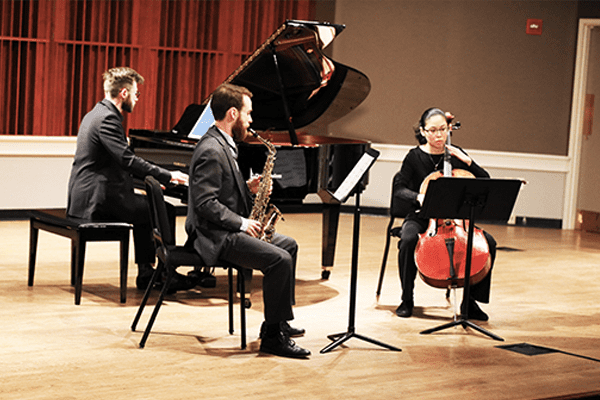“Over the years, we found that the younger students (freshmen, sophomores) really struggled with this amount of freedom, and needed a little more direction.”
I think it is safe to say that we all view band as the ultimate “group project.” Every student plays a crucial role in the overall quality of the bigger picture. However, we often struggle with getting every student on the same page when it comes to basic musical skills (intonation, phrasing, dynamics, etc.). Instead of teaching these concepts to a large ensemble with varied instrumentation, it may be beneficial to explore the opportunities that chamber music can provide. Whether you can find ways to incorporate chamber ensembles into your daily curriculum or build your own after school program, there are numerous possibilities that these types of experiences can open up for your students.
Curricular Chamber Ensembles
We have done a Chamber Ensemble Unit with our bands for the past several years, and it has taken on many different forms. In the beginning, we used to split the two younger bands up into small ensembles (trios, quartets, quintets, and sextets). The students would rehearse during class time (usually two or three days a week), and directors would rotate around to each group to check in on their progress. Having multiple directors helps to identify what the students need on a more personal level. Over the years, we found that the younger students (freshmen, sophomores) really struggled with this amount of freedom, and needed a little more direction. Now, we tend to stick to larger ensembles (woodwind or brass choirs, large percussion ensembles) for our Concert Band (basic) students. This way, each ensemble has a specific director working with them each time they rehearse.
“The only way this works is if you have the facilities to split the group up into multiple areas.”
The Symphonic Band (intermediate) students are a little more mature and can work a little more independently in groups of three-to-six players. Wind Symphony (advanced) students are able to form their own ensembles, but are not given class time to prepare. Their work is all independent, outside of the school day.
The only way this works is if you have the facilities to split the group up into multiple areas. We have had to get creative with this over the years, expanding beyond the typical practice rooms or ensemble rooms. It would not be uncommon to have a group rehearsing in the lobby of our theater, in a hallway, or even in the loading dock area for our marching band trailer! The bottom line is…don’t be afraid to spread out. Ask if there are any classrooms near you that aren’t being used, or if you can share spaces with other groups throughout your building.
We end the unit with a Chamber Ensemble Recital. We have typically done this unit during the winter months, leading up to our state-adjudicated Solo & Ensemble event, which we require our younger bands to attend. However, this year we shifted it to the first quarter of the school year. Starting right at the beginning of the year proved very helpful to establishing group leadership, and for us to teach those musical concepts discussed earlier in a small group setting. Our recital was done in October, which is a difficult month due to marching band. However, we felt that the students needed a concert opportunity earlier in the school year, rather than waiting until the first band concerts in December. Starting the year off with our Chamber Ensemble Recital was a great way to ease them into the school year and give them a feeling of rehearsing and performing much earlier.
Co-Curricular Ensembles
We are also fortunate to have some great private lesson teachers at Centerville, and these teachers will often put together their own chamber ensembles. These ensembles started out as voluntary groups, but due to interest, we have had to hold auditions in the past. These ensembles meet entirely outside of class with a teacher who “coaches” the ensemble throughout their rehearsals. We have had a brass choir, percussion ensemble, saxophone quartet and clarinet quartet in recent years. In 2016, we had an incredible experience with our saxophone quartet and clarinet quartet at the Music for All Chamber Music National Festival in Indianapolis. This allowed our students to perform on a national stage, while also absorbing some of the amazing musical talents from other students just like them from across the country.
Hopefully, you can see the benefits of adding these musical opportunities for your students. It takes a degree of planning and preparation, but the pay-off is worth it! Students feel a strong sense of ownership over their ensemble, and it is a great way to teach them the importance of every single player. It also allows parents to hear and see their student in a way that demonstrates their abilities.



